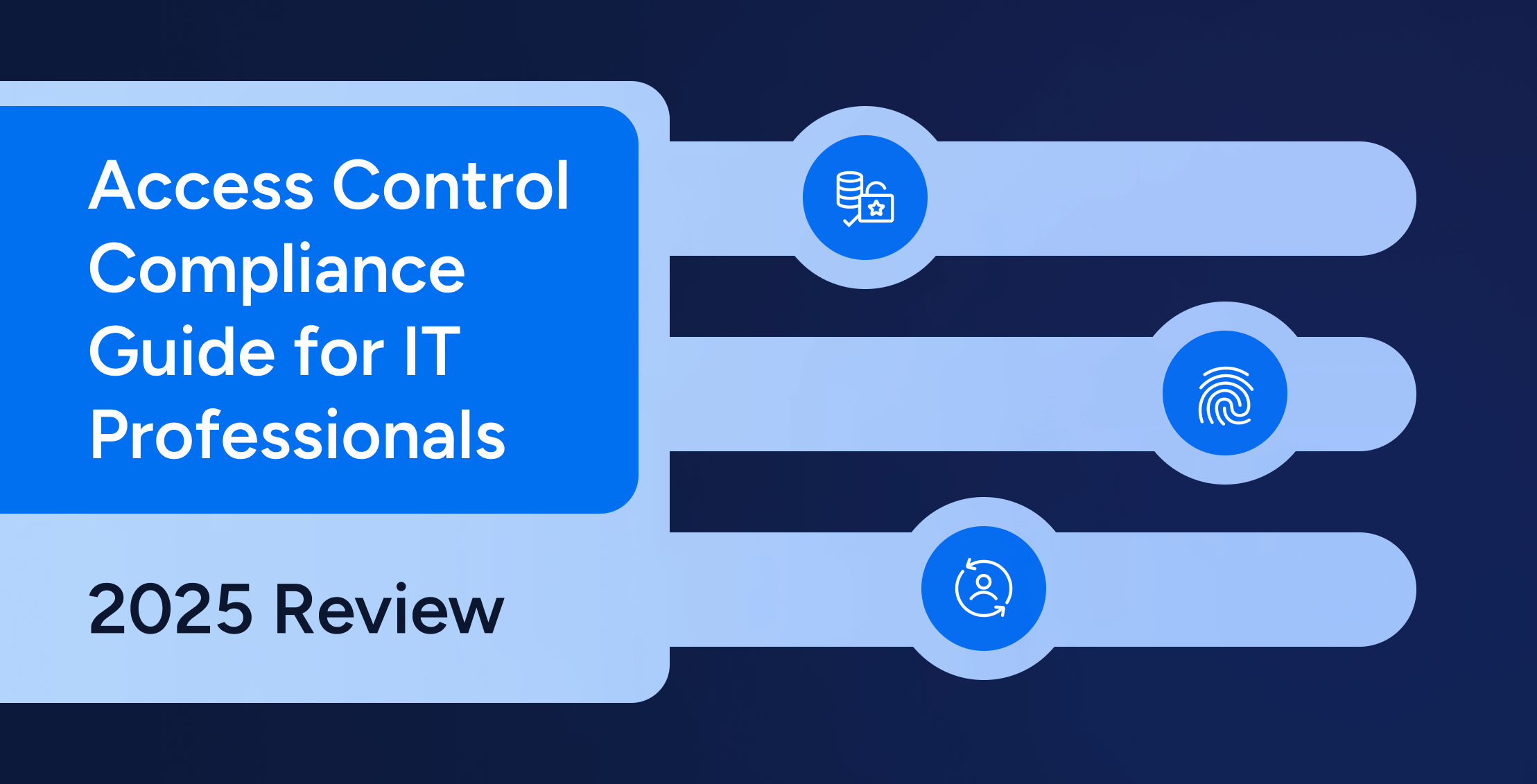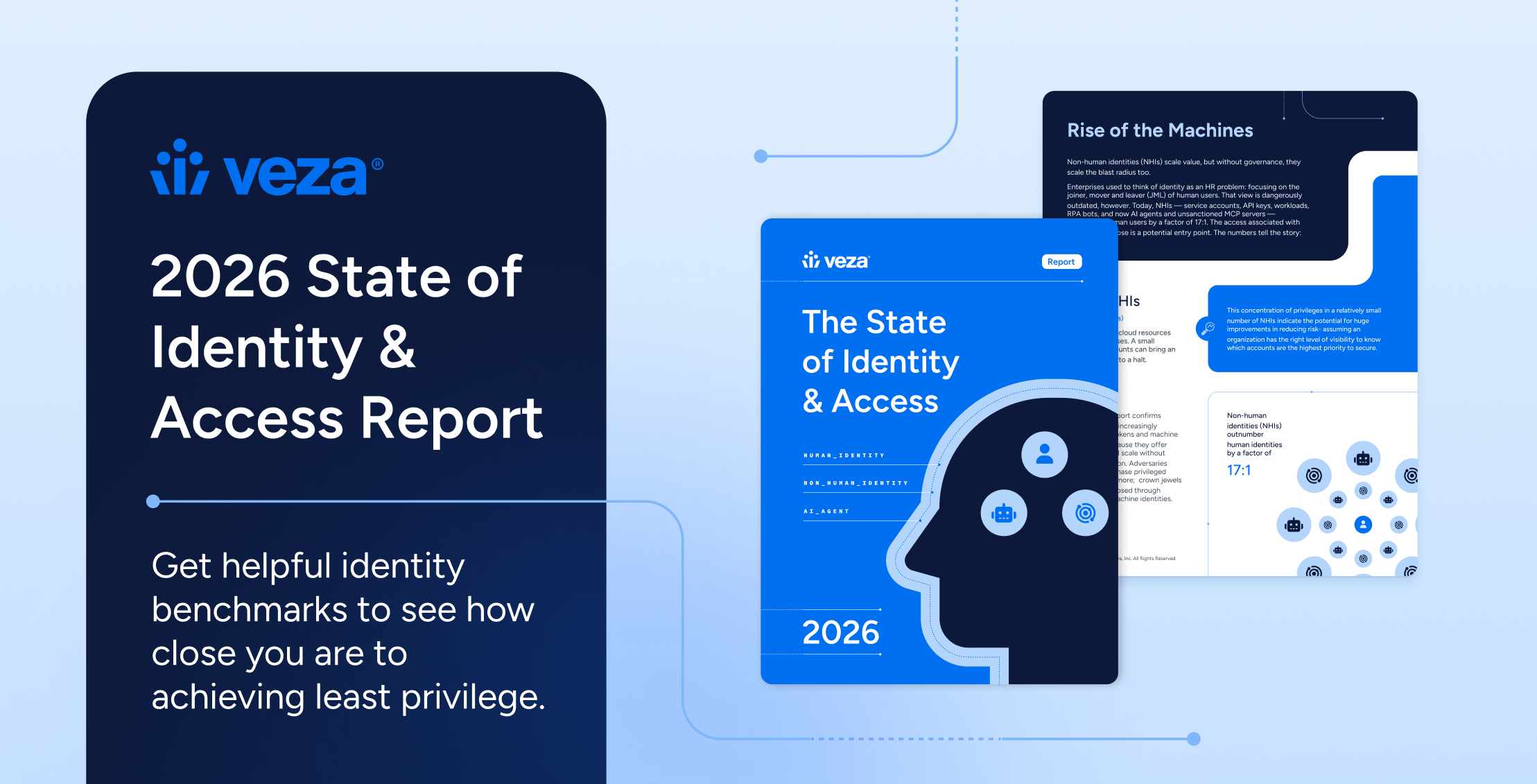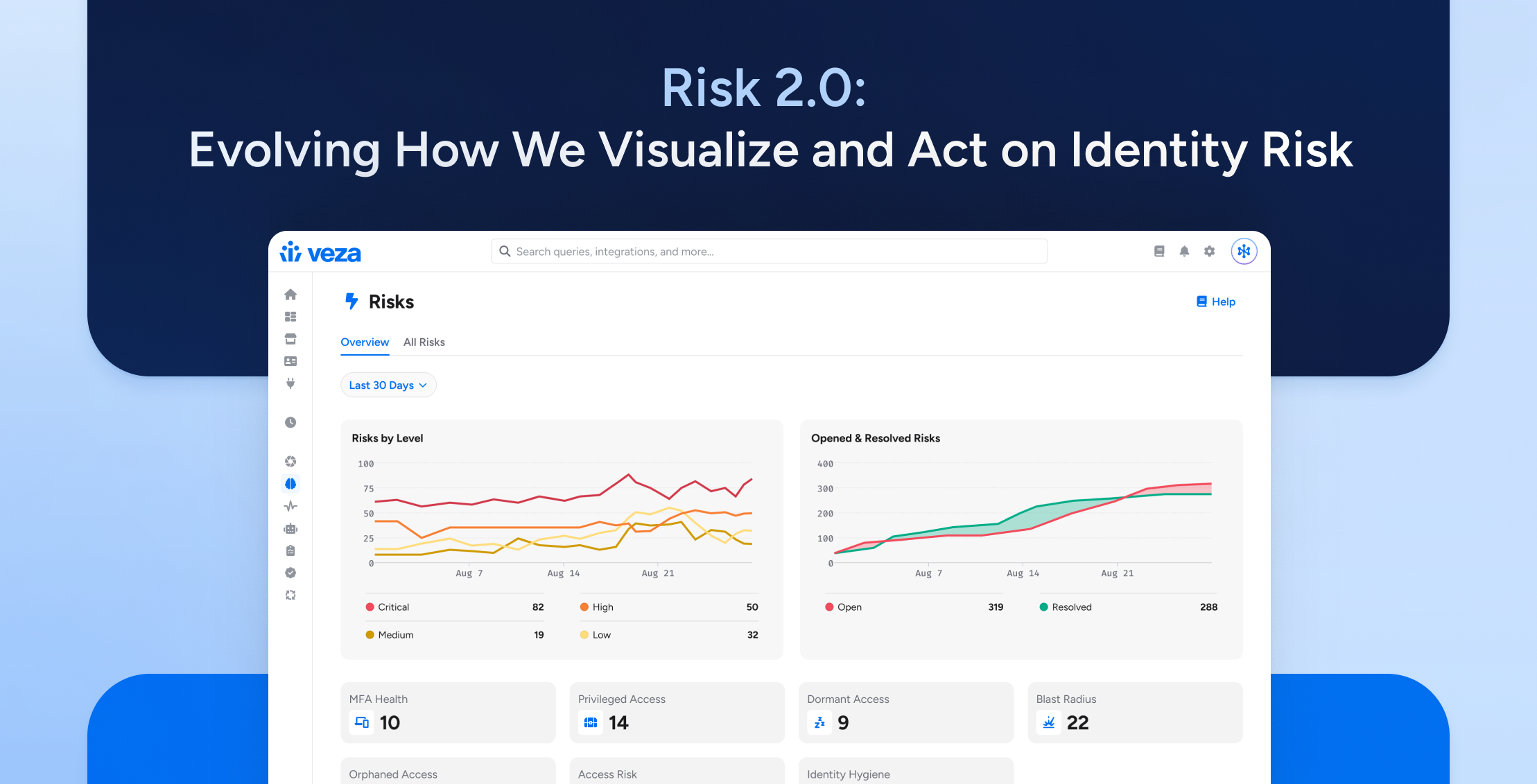
Access control compliance is a constant battle for most organizations. With cyberattacks that increasingly target identity systems to exploit excessive privileges, dormant accounts, and mismanaged permissions, and regulations like GDPR, HIPAA, and PCI-DSS imposing stricter standards all the time, outdated methods or partial solutions no longer constitute effective access control.
Yet many businesses still approach compliance as if it’s just about controlling who logs in or out of their networks. Most overlook the complexities of managing granular effective permissions, tracking subtle changes in user roles, or identifying hidden non-human identities (like service accounts and APIs) scattered across their infrastructure.
This article covers everything you need to know about effective, permission-based access control compliance, why traditional identity management tools often fall short, and how to make sure your organization stays secure, compliant, and audit-ready, no matter how complex your environment becomes.
What is access control in cybersecurity?
Access control in cybersecurity means managing who can access your organization’s digital infrastructure. It’s the combination of policies and technologies that organizations use to determine who can use data, applications, and resources, and under what circumstances.
The goal of access control is to prevent unauthorized access to sensitive systems. Most organizations accomplish this with authentication (verifying who users are) and authorization (determining what users can access). Done well, access control can help your organization secure its sensitive data and systems, reduce the risk of breaches, and comply with certain regulations.
Common access control methods include:
- Passwords and multi-factor authentication (MFA): Requiring multiple proofs of identity (e.g., password, security token, or biometric verification) to grant access.
- Biometric authentication: Using unique physical characteristics like fingerprints or facial recognition to identify users.
- Encryption: Securing data so only authorized users can read or access it.
Another important part of access control is managing user permissions and accounts, called identity governance and administration (IGA). Here’s what that usually involves:
- Role-based access control (RBAC): Giving users specific permissions based on their role in the company so they only have access to the tools and data they genuinely need.
- User provisioning and deprovisioning: Setting up and removing user accounts as people join teams, change roles, or leave jobs.
- Periodic access reviews: Regularly checking to make sure users have the correct permissions and removing any they no longer need.
Why is access control important?
Effective access control is important for keeping information secure, keeping data accurate, reducing risks, building trust, lowering costs, and meeting compliance requirements.
Access control can help your organization with:
- Information security: Preventing unauthorized users from accessing sensitive information and reducing the risk of data breaches.
- Data integrity: Ensuring only authorized users can view, change, or delete critical data to preserve accuracy and reliability.
- Regulatory compliance: Meeting requirements set by regulations like GDPR, HIPAA, PCI-DSS, and more to avoid hefty fines and legal penalties.
- Risk mitigation: Limiting exposure to insider threats, external cyberattacks, and accidental security breaches.
- Trust and reputation: Proving to customers, partners, and regulatory authorities that your business takes security seriously.
- Cost reduction: Avoiding financial and reputational damage associated with security incidents, including legal actions and regulatory fines.
How access control works
Access control works by using clearly defined rules and processes to grant or deny permissions to users. Most organizations manage access control using specialized software that performs four key functions:
- Authentication: Confirming a user’s identity using passwords, MFA, biometric scans, or tokens.
- Authorization: Determining the resources or actions a user can take based on predefined permissions.
- Access control lists (ACLs): Listing who (individuals or groups) can access specific resources, like files, network devices, or databases.
- Auditing and logging: Tracking user activity to identify unauthorized access attempts for more effective security monitoring and rapid incident response.
Today, access control software is all but essential for managing access policies. With features like role-based access control, single sign-on (SSO), and privileged access management (PAM), a modern identity security solution like Veza can significantly streamline your organization’s access control and strengthen its identity security posture.
What is access control compliance?
Access control compliance means following the regulations and industry standards that define how organizations manage who can access sensitive data and critical systems. Having proper access control compliance means your organization can clearly show:
- Who has access to sensitive information and why they need it.
- What actions those users can perform with their access.
- How regularly those permissions are reviewed, updated, and documented.
Effective access control compliance can help reduce the risk of unauthorized access, failed audits, and costly data breaches. When compliance fails, however, the consequences can be severe. For instance, weak access control is what allowed attackers to steal sensitive data from roughly 147 million people in the infamous 2017 Equifax breach—an incident that resulted in lawsuits, fines, and lasting reputational damage.
Yet despite the repercussions, many still struggle to manage access control compliance effectively. Traditional identity tools (Microsoft Active Directory, Okta, Google Workspace, etc.) are great for managing users and groups, but they simply weren’t built for today’s compliance demands.
With modern identities scattered across distributed systems using different languages and rules, legacy platforms just can’t provide enough insight into effective permissions. Now, organizations need a more intelligent way to manage access compliance at scale.
A modern identity security solution like Veza can help your organization simplify access control management across its entire ecosystem. With instant, real-time visibility into exactly who (human and non-human identities) can do what (create, read, update, or delete) and why across all data and resources, Veza makes the how (proving compliance) easier than ever—with automated access reviews, real-time alerts on permission changes, detailed historical logging, and auditable documentation all in one place.
Types of compliance for access control
Depending on your industry, location, or the kind of data you handle, you’ll likely need to follow different data privacy and compliance laws and standards designed to protect sensitive information and ensure accountability. Most common frameworks, like SOX, PCI-DSS, SOC 2, ISO 27001, HIPAA, and GDPR, have their own requirements for managing user access and permissions.
Understanding the different types of compliance for access control and where they overlap will be key for organizations to manage identity security effectively.
SOX (Sarbanes-Oxley Act)
The Sarbanes-Oxley Act (SOX) applies to all publicly traded companies in the United States. It protects investors and the public by improving the accuracy, transparency, and reliability of corporate financial reporting. While SOX does not explicitly outline “access controls,” Section 404 legally requires publicly traded companies to establish robust internal controls over financial reporting (ICFR).
An important part of these internal controls is known as Information Technology General Controls (ITGCs), which address user access management specifically. ITGCs help make sure only authorized personnel can access critical financial data and systems to preserve the integrity of financial reporting.
Access control requirements under SOX:
- Regular access reviews: Periodically verifying user access rights match job responsibilities.
- User lifecycle management: Clearly documenting and managing permissions as employees join, change roles, or leave.
- Privileged access management (PAM): Defining and strictly controlling the permissions granted to administrators and other privileged users.
- Detailed activity logging: Keeping accurate, auditable logs of access to financial systems and data.
While SOX sets the broader requirements, the Public Company Accounting Oversight Board (PCAOB) provides detailed guidance in its Auditing Standard No. 5 (AS5), which instructs auditors on evaluating how well companies manage these access controls.
How Veza can help with SOX compliance: Veza automatically captures and documents detailed permission data across financial reporting systems like ERPs, accounting software, and financial databases to simplify user access reviews and produce PCAOB-aligned, audit-ready evidence.
Check out Veza’s SOX compliance checklist to learn how to comply in 2025.
PCI-DSS (Payment Card Industry Data Security Standard)
The Payment Card Industry Data Security Standard (PCI-DSS) applies to any organization that processes, stores, or transmits credit card information–like retail stores, e-commerce sites, payment processors, financial institutions, and more. It requires companies to implement strict access control measures to make sure financial information stays secure.
Access control requirements under PCI-DSS:
- Role-based access restrictions (Requirement 7): Restricting access to cardholder data by user roles and responsibilities.
- Strong authentication (Requirement 8): Identifying and authenticating access to system components.
- Detailed logging and monitoring (Requirement 10): Tracking and recording user access activities to cardholder data, and maintaining detailed logs that include successful and failed access attempts, user actions, and changes to permissions.
How Veza can help with PCI-DSS compliance: Veza automatically maps and continuously monitors real-time permissions, user actions, and over-permissioned accounts across every system handling cardholder data–from payment gateways and databases to cloud storage and POS applications.
Read about why PCI DSS 4.0 compliance with Veza is a game-changer for financial services companies.
SOC 2 (Service Organization Control 2)
Service Organization Control 2 (SOC2) applies to service organizations–especially SaaS companies, cloud vendors, and managed service providers (MSPs)–that store, process, or transmit sensitive customer information. While not legally mandatory, SOC 2 certification can be a competitive advantage. For most stakeholders, it’s a sign of your organization’s commitment to data security, customer trust, contractual requirements.
SOC 2 compliance is structured around five Trust Service Criteria (TSC): Security, Availability, Processing, Integrity, Confidentiality, and Privacy. To meet SOC 2’s Security criteria, companies must implement physical and logical access controls to ensure only authorized users can access systems, applications, and sensitive data.
Access control requirements under SOC 2:
- Logical access restrictions: Clearly defined permissions ensuring that users can only access systems and data required for their roles.
- Authentication controls: Strong user identification and authentication methods (including MFA) to validate user identities.
- User activity monitoring: Continuous tracking and reviewing of all user actions, access attempts, and system activities, with detailed, auditable logs for compliance reporting.
How Veza can help with SOC 2 compliance: Veza centralizes detailed permission data from all your SaaS apps, cloud services, and data systems into a single, auditable platform that automatically monitors user activities, enforces least-privilege access, provides real-time alerts, and compiles comprehensive audit trails.
Learn why Veza is SOC 2 Type II Certified and what that means for your organization.
ISO 27001 (International Standard for Information Security)
ISO/IEC 27001:2022 is an internationally recognized standard for managing information security using an Information Security Management Systems (ISMS), a documented framework of policies and processes designed to protect an organization’s sensitive data from security threats.
Today, ISO 27001 compliance is essential or strongly recommended for organizations that handle sensitive information, including financial services firms, healthcare providers, tech companies, and any other business looking to demonstrate resilience to customers, partners, and regulators.
Annex A of ISO/IEC 27001 outlines specific guidelines for access control management, particularly:
- Annex A.9.1 (Access Control Policy)
- Annex A.9.2 (User Access Management)
- Annex A.9.4 (System and Application Access Control)
Under each annex, organizations must carefully control who accesses information, define the permissions associated with each user, and regularly verify that access stays appropriate and secure.
Access control requirements under ISO 27001:
- Clear access control policy (A.9.1.1): Establishing and maintaining documented policies clearly outlining how access permissions are granted, reviewed, and revoked.
- User registration and de-registration (A.9.2.1): Managing user identities and the access lifecycle from onboarding through role changes and offboarding.
- Review of user access rights (A.9.2.5): Regularly verifying user permissions align with current roles and responsibilities.
- Privileged access management (A.9.2.3): Restricting, monitoring, and tightly controlling administrative privileges.
- Secure log-on procedures (A.9.4.2): Implementing user authentication methods (like MFA) to verify user identities and prevent unauthorized access.
How Veza can help with ISO/IEC 27001 compliance: Veza streamlines the path to ISO/IEC 27001 certification with automated access reviews (A.9.2.5), user lifecycle management (A.9.2.1), and audit-ready activity logging (A.9.4.2) to reduce time spent on compliance, and real-time privileged access monitoring (A.9.2.3) to close compliance gaps from outdated or excessive permissions.
Discover why Veza’s ISO 27001 certification underscores its commitment to risk management, cyber resilience, and operational excellence.
HIPAA (Health Insurance Portability and Accountability Act)
The Health Insurance Portability and Accountability Act (HIPAA) applies to organizations that handle protected health information (PHI), like healthcare providers, health insurance companies, and healthcare clearinghouses. Mandatory for these organizations, HIPAA is designed to ensure the confidentiality, integrity, and availability of sensitive patient data.
Under HIPAA’s Security Rule (45 CFR § 164.312(a)(1)), covered entities must implement specific technical safeguards, particularly around access control, to make sure only authorized individuals can view or handle sensitive patient records. HIPAA compliance can reduce the likelihood of PHI breaches, protect patients from potential harm, and prevent costly legal and reputational fallout.
Access control requirements under HIPAA:
- Unique user identification: Assigning a unique ID to track user activities and maintain accountability over who access patient information.
- Minimum necessary access: Enforcing strict controls that limit each user’s access only to the PHI necessary for their specific job functions.
- Strong authentication: Using secure authentication methods (like strong passwords or MFA) to verify user identities before granting access to PHI.
- RBAC: Managing permissions systematically based on clearly defined roles so each user has the least privilege necessary to perform their job effectively.
How Veza can help with HIPAA compliance: Veza automates access reviews and provides instantly visibility into exactly who can access patient data, continuously enforces least privilege to reduce PHI breach risks, and generates detailed audit logs across EHRs, cloud apps, and data infrastructure for faster, easier HIPAA audits.
Check out Veza’s Healthcare Solution Brief to learn more about automating HIPAA compliance.
GDPR (General Data Protection Regulation)
The General Data Protection Regulation (GDPR) is designed to protect the personal data and privacy rights of individuals in the European Union (EU). GDPR compliance is mandatory for any organization, regardless of location, that processes, stores, or manages the personal data of EU residents. Non-compliance can lead to severe penalties, including fines up to €20 million or 4% of global annual revenue (whichever is greater), plus reputational damage and loss of customer trust.
GDPR emphasizes “data minimization” and “purpose limitation,” or limiting data access to only those individuals who absolutely require it, and strictly for the purposes explicitly stated. Access control requirements under GDPR call for organizations to implement technical and organizational safeguards that protect personal information against unauthorized or unlawful processing.
Access control requirements under GDPR:
- Data minimization (Article 5(1)(c)): Ensuring users have only the minimal necessary access required to perform their roles.
- Purpose limitation (Article 5(1)(b)): Limiting personal data access exclusively to the specific purposes communicated and agreed upon.
- Technical safeguards (Article 32): Implementing secure authentication measures like MFA and encryption.
- Detailed audit trails: Keeping auditable records of who accessed personal data, what actions were performed, and for what purposes (demonstrating compliance and accountability per Article 5(2)).
How Veza can help with GDPR compliance: Veza makes GDPR audits simpler, faster, and far less stressful with continuous least-privilege enforcement for access to personal data, automatically generated audit-ready records of exactly who accessed data and why, and real-time identification for unnecessary or excessive permissions across your SaaS applications, databases, cloud infrastructure, and custom systems.
Learn how Veza helps global organizations simplify GDPR compliance and protect personal data at scale.
| Access Control Requirement | SOX | PCI-DSS | SOC 2 | ISO 27001 | HIPAA | GDPR | How Veza Helps |
| Access Reviews | Yes | Partial | Yes | Yes | Yes | Yes | Automates regular access reviews to ensure role alignment and detect risk. |
| Role-Based Access Control (RBAC) | Yes | Yes | Yes | Yes | Yes | Yes | Maps role definitions and enforces least-privilege access across systems. |
| Privileged Access Management (PAM) | Yes | Partial | Yes | Yes | Partial | Partial | Monitors and restricts privileged user permissions in real time. |
| User Lifecycle Management | Yes | Partial | Yes | Yes | Yes | Yes | Manages joiner-mover-leaver processes with continuous permission updates. |
| Strong Authentication / MFA | Indirect | Yes | Yes | Yes | Yes | Yes | Ensures MFA enforcement visibility across apps and infrastructure. |
| Detailed Logging & Audit Trails | Yes | Yes | Yes | Yes | Yes | Yes | Provides audit-ready logs for all access actions, user changes, and system events. |
| Access Control Policy Documentation | Indirect | Indirect | Yes | Yes | Yes | Yes | Centralizes and documents policy enforcement and access rationale. |
| Least Privilege Enforcement | Partial | Yes | Yes | Yes | Yes | Yes | Continuously evaluates and corrects over-permissioned access. |
| Compliance-Specific Mapping | SOX-specific logs & PCAOB AS5 alignment | PCI Req 7, 8, 10 | Trust Services Criteria (Security) | Annex A.9 | 45 CFR § 164.312 | GDPR Articles 5 & 32 | Maps all permissions to compliance-specific requirements with real-time alignment. |
- Partial: The requirement is not universally mandated by the framework but is applicable in certain situations or implied by related clauses.
- Indirect: The framework does not explicitly require the control, but it’s considered necessary to meet other core obligations (e.g., maintaining integrity or accountability).
What happens if you’re not compliant?
Non-compliance with access control regulations has serious consequences. Here’s what to expect:
- Increased risk of data breaches: Without proper access controls, your organization is vulnerable to unauthorized access, data theft, and cyberattacks that can stay undetected (and wreak havoc) for long periods of time.
- Costly regulatory fines: Non-compliance can trigger significant financial penalties, including HIPAA fines up to $50,000 per violation.
→ Example: Anthem Inc. faced a $16 million HIPAA fine after inadequate access controls led to a breach affecting 79 million people.
- Legal liabilities and lawsuits: Affected customers and business partners may pursue expensive class-action lawsuits.
→ Example: Target Corporation paid $18.5 million to settle class-action lawsuits stemming from a PCI-DSS violation that exposed customer financial data.
- Damage to reputation and trust: Regulatory actions and lawsuits can reflect poorly on your organization’s reputation, leading to lost customer trust–and lost revenue.
How to comply with access control requirements
Meeting access control compliance doesn’t have to be so complicated. Combine the following practical best practices with a modern solution like Veza to simplify the entire process.
- Choose the right access control method
Understanding and selecting the right access control model for your organization’s specific needs helps reduce complexity and makes compliance easier. The main methods include:
- RBAC (role-based access control): Assigning permissions based on clearly defined user roles to simplify management and scalability across larger organizations. RBAC is especially valuable for complying with regulations that require role-specific permissions like SOX and HIPAA.
→ Best for: Complying with regulations requiring role-specific permissions like SOX and HIPAA.
- Policy-based access control (PBAC): Using dynamic policies to grant access based on user, resource, and contextual factors to help organizations enforce consistent compliance even as circumstances change.
→ Best for: Complex, constantly evolving environments like cloud infrastructure or SaaS applications.
- Attribute-based access control (ABAC): Assigning access based on detailed attributes of users, resources, or the environment (like user location, device, and time of day) for highly granular and precise control.
→ Best for: Managing sensitive data under GDPR or PCI-DSS requirements.
- Mandatory access control (MAC): Restricting control over permissions to administrators based on predefined rules for stringent compliance and consistent enforcement of access policies.
→ Best for: High-security or regulated environments including government or military settings.
- Discretionary Access Control (DAC): Giving resource owners direct control over permissions. While flexible and easy to implement, DAC requires careful oversight to avoid compliance risks from unauthorized or excessive permissions.
→ Best for: Less regulated environments or individual user-managed data systems.
How Veza can help: Veza automatically maps roles and permissions from all your systems, including cloud services (AWS, Azure, GCP), SaaS apps, and data platforms like Snowflake to help teams quickly understand their existing access model and determine which control method (RBAC, ABAC, PBAC, MAC, DAC) best matches their security and compliance needs.
- Use a Zero Trust policy
A Zero Trust policy means never automatically trusting any access request—even when it comes from within your own network. Instead, Zero Trust is about continuously verifying each access attempt against factors like user identity, device security, network conditions, and data sensitivity. It’s effective when it works, but Zero Trust can also be tricky.
Too often, Zero Trust creates too much tension between security and convenience. Too strict, and users get frustrated and productivity declines; too lax, and you open the door to security threats.
The key to making Zero Trust successful is finding the right balance. Organizations need systems smart enough to evaluate context in real-time and flexible enough to adapt as risks and user needs change. Otherwise, teams might try to bypass strict controls for convenience and unintentionally increase the risk of unauthorized access or compliance violations.
How Veza can help: Veza makes Zero Trust practical so teams don’t need to compromise on convenience or security. It automatically assesses access requests against context-aware, policy-driven rules, dynamically evaluating identity, device, permission context, and more, and instantly granting or denying access based on real-time risk.
- Follow the principle of least privilege
Following the principle of least privilege (PoLP) means giving users only the exact permissions they need to do their jobs and nothing more. Restricting access to only what’s necessary can help organizations dramatically reduce the risk of insider threats, unauthorized access, and accidental breaches. But organizations often struggle with how to accurately define those boundaries, especially as roles and responsibilities change over time.
What makes least privilege challenging is its dynamic nature. User permissions rarely stay static; they expand subtly over time, creating a phenomenon known as privilege creep. Today, regulations like GDPR, HIPAA, and PCI-DSS explicitly call for least privilege because the lack of control over permissions can dramatically increase the risk of unauthorized access, insider threats, and accidental breaches.
How Veza can help: Veza puts least privilege into practice. It continuously monitors real-world permissions across all your applications, cloud environments, and data systems, pinpointing exactly which permissions users actually need, and which ones they don’t.
And, it proactively identifies over-permissioned accounts, dormant permissions, and privilege drift, giving your team actionable recommendations on how to reduce risks without disrupting business operations.
- Properly manage access requests
Managing access requests effectively is essential for protecting sensitive data and meeting compliance requirements. Poorly managed access governance, on the other hand, can quickly lead to security risks like over-provisioning and privilege creep. Instead, a secure and well-managed access request process should:
- Make sure each request is validated, clearly justified, and approved using consistent workflows to uphold accountability and oversight.
- Establish temporary, just-in-time access that automatically expires to reduce the risk of unnecessary or prolonged privileges.
- Automatically log every decision for auditability.
How Veza can help: Veza’s automated approvals, built-in separation-of-duties checks, and detailed audit logs help streamline compliance efforts, reduce security risks, and boost employee productivity, all without overwhelming your security and IT teams.
- Continuously monitor access
Continuously monitoring access is essential to identify unusual behavior or unauthorized access attempts before they escalate into serious incidents. Often an organization’s first line of defense against unnoticed breaches and insider threats, regular monitoring includes reviewing user activities, tracking changes in permissions, and quickly investigating alerts when something unusual happens.
Without it, suspicious activity (like an employee suddenly downloading sensitive customer records or an inactive account gaining access to critical databases) can potentially cause irreparable damage long before anyone notices.
How Veza can help: Veza actively monitors user permissions, identity activity, and resource usage across your entire infrastructure. When it detects unusual behavior, like unexpected privilege changes or dormant account activations, Veza immediately alerts your security and compliance teams to help your organizations stay ahead of threats and simplify audits.
- Maintain consistent provisioning & deprovisioning
Provisioning (granting access when someone joins or changes roles) and deprovisioning (removing access when someone leaves or switches roles) are important processes that protect your sensitive data and support compliance. But they’re also notoriously easy to overlook or mismanage.
Even short delays in removing access when an employee leaves can leave dormant accounts for attackers to exploit later or accidental breaches by former employees who keep access after they need it. On the flip side, slow or inconsistent provisioning can be frustrating for employees. Some may even bypass approved processes or request overly broad permissions to avoid them.
How Veza can help: Veza automates the entire provisioning and deprovisioning lifecycle by continuously syncing with your HR systems and identity directories to make sure access rights always align with employee status–from onboarding and role changes to removing access when someone leaves.
- Conduct regular access reviews & audits
Regular access reviews and audits help organizations detect and resolve permission issues–like unnecessary privileges, inactive user accounts, and potential compliance violations. Periodically verifying user access rights against their current roles and responsibilities can reduce the risk of outdated permissions and privilege creep.
It can also demonstrate to regulators and auditors that your company has tight control over sensitive data and complies with standards like GDPR, HIPAA, and ISO 27001.
How Veza can help: Veza automatically compiles detailed reports of user permissions, using built-in intelligence to highlight accounts with excessive, unused, or risky permissions so teams can easily see and fix issues before they become security incidents or audit findings.
- Implement and enforce security protocols
Implementing strong security protocols is critical for protecting sensitive data and demonstrating compliance with frameworks like ISO 27001, HIPAA, and PCI-DSS. But simply setting policies isn’t enough today. The real challenge lies in consistently enforcing these protocols to make sure they’re effective. To do so, organizations must integrate them deeply into daily processes, where:
- MFA is mandatory for all access to sensitive systems, not just recommended.
- Data encryption protocols apply automatically to sensitive information, whether stored in the cloud, sent via email, or stored in local databases.
- Intrusion detection and response mechanisms operate continuously in the background, identifying security anomalies before attackers can exploit vulnerabilities.
Strong security protocols also means clearly defining who’s responsible for enforcement. Organizations should explicitly assign and empower teams, like SOCs (Security Operations Centers) or compliance teams, to monitor adherence to these protocols, investigate deviations, and respond to potential violations immediately.
How Veza can help: Veza actively monitors compliance with critical security protocols across your entire infrastructure, clearly surfacing areas where security protocols aren’t enforced, and sending proactive alerts straight to your security team for instant investigation and response.
Simplify your access control compliance
True identity security takes more than basic audits and surface-level controls. Hidden complexities in today’s enterprise environments–fragmented identities, shadow IT accounts, and non-human identities operating unnoticed–can quietly undermine even the best compliance programs.
Instead, Veza is redefining access control compliance from the permissions up. Built on the industry’s first Access Graph, Veza captures and visualizes the granular permissions that actually determine security and compliance. Its intuitive platform reveals exactly who (or what) can take critical actions (like creating, reading, updating, or deleting sensitive data) across every system your business relies on.
With Veza, your teams can:
- Close the permissions gap by mapping effective access rights to real-world identities, including machine and service accounts traditionally missed by legacy IGA and PAM tools.
- Proactively mitigate risks with intelligent, automated detection of dormant accounts, over-permissioning, and privilege creep before they trigger compliance failures or breaches.
- Instantly respond to auditor requests by generating detailed, audit-ready reports showing historical access, permission justifications, and compliance with regulatory frameworks like SOX, GDPR, HIPAA, and ISO 27001.
- Adapt compliance effortlessly to emerging requirements like GenAI governance, securing access across AI-driven systems, APIs, and data repositories.
Ready to go deeper?
- Read Amber Li’s take on SOC 1 compliance—a sharp breakdown from a product leader who’s sat on both sides of the audit table
- Use our SOX Compliance Checklist to align your access reviews with regulatory expectations
- Watch the on-demand webinar, Blackstone’s Approach to Identity Governance with Veza, to learn how a leading financial firm leverages Veza for risk reduction, continuous compliance, and least privilege enforcement.
- See how Veza fits your environment by scheduling a tailored demo, and get a personalized walkthrough of our platform’s capabilities.
About the Authors
This article was developed in collaboration between Mariah Brooks, an independent consultant and researcher focused on identity security, and Matthew Romero, Technical Product Marketing Manager at Veza.
Mariah brings deep experience translating complex technical challenges into practical, real-world insight. With a background spanning identity governance, cyber risk, and responsible AI, she’s spent 5 years working alongside CISOs and security architects to unpack emerging issues like Non-Human Identities (NHI). Her clarity, context, and credibility make her a trusted voice for security leaders navigating high-stakes access decisions.
Matthew brings a strategic marketing lens grounded in the realities of modern enterprise security. At Veza, he helps define go-to-market positioning for identity-first security solutions, bridging the gap between technical innovation and customer relevance. His work focuses on connecting product capabilities to the risks and operational demands security teams face every day.
Learn more about their work:
Mariah Brooks – LinkedIn
Matthew Romero – LinkedIn




